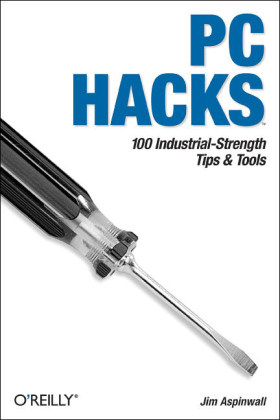
PC Hacks
O'Reilly Media (Verlag)
978-0-596-00748-5 (ISBN)
- Titel ist leider vergriffen;
keine Neuauflage - Artikel merken
Intel-and AMD-powered PCs--which account for more than 90 per cent of all personal computers--are powerful and expandable, and operating systems like Windows and Linux do a great job of running well on this hardware. But to maintain maximum stability and predictability, these operating systems don't push the hardware to its limits. That doesn't mean you can't. PC Hacks shows PC users like you how to get the most out of your hardware and software to make your PC experience more satisfying than ever. You don't need another collection of simple tips and command-clicks; you need PC Hacks, where you'll find proven techniques for enhancing performance and preventing problems with your PC hardware. This step-by-step, hack-by-hack guide, with invaluable tips and tricks throughout, will get you hacking the system board, CPU, BIOS, peripherals and operating system--everything but the unhackable power supply! In PC Hacks, Jim Aspinwall, the Windows Helpdesk columnist and feature editor for CNET.COM and author of three books on PC maintenance, delivers basic to advanced hacks for overclocking CPU and video cards, tweaking RAM timing, selecting the best performing components, and much more.
He includes suggestions for reusing an old PC to off-load work from newer systems as well as ways to prevent security hacks. He also offers many tips for avoiding common mistakes--and for getting the system back up and running if something does go wrong. PC Hacks combines of the bestselling Hacks series style with the world's most popular computing hardware. Presented in a clear and direct format and covering both Windows and Linux operating systems, PC Hacks ensure that you'll hack and tweak your way to the best performance possible out of your trusty PC.
Jim Aspinwall has been the Windows Helpdesk columnist and feature editor for CNET.COM and author of three books on PC maintenance. A resident of Campbell, California, Jim is also an amateur radio operator, electronics technician, and OSHA certified tower climber, maintaining radio transmission sites in northern California.
Credits; Preface; Chapter 1. Basic System Board Hacks 1. Lock Others Out of Your Computer; 2. Bypass the BIOS Password; 3. Recover a BIOS That Won't Boot; 4. Boot Faster; 5. Display a Boot-Time Graphic; 6. Configure Boot Device Order; 7. Set Your Clock Back; 8. Avoid the Legacy USB Option; 9. Hack an Unhackable BIOS 10. Upgrade Your Flash BIOS; Chapter 2. Basic System Board Setup 11. Step Away from the Legacy Device; 12. Manage Devices 13. Configure Serial Ports; 14. Configure Parallel Ports 15. Configure Sound Cards; 16. Configure SCSI Host Adapters 17. Configure Network Cards; 18. Reeducate Plug and Play Chapter 3. CPU Hacks; 19. Get More Power; 20. Identify Your CPU; 21. Which CPUs Are Hackable?; 22. Which System Boards Are Hackable?; 23. Determine Your CPU Speed; 24. Keep It Cool 25. Control CPU Clock Speed from the BIOS; 26. As Goes Voltage, So Goes Speed; 27. Set the CPU Multiplier; 28. Unlock Your CPU Multiplier; 29. Check the Vents; Chapter 4. Memory Hacks 30. Install More RAM; 31. Recognize Memory Limitations;;;; 32. Install the RAM Your Operating System Needs; 33. Tame the Windows 95 and 98 Cache; 34. Manage the Paging File; 35. Manage Windows System Resources; 36. Force Windows 98 and Me to Swap Less; 37. Pin the Kernel in RAM; 38. Speed Up Your RAM 39. Enable Memory Interleave for Via Chipsets; Chapter 5. Disk Hacks; 40. Partition and Format Wisely; 41. Determine Your Filesystem; 42. Create a New Partition with NT, 2000, XP, and 2003; 43. Create a New Partition with PartitionMagic; 44. Merge Partitions with PartitionMagic; 45. Convert FAT to NTFS 46. Create or Delete NTFS Partitions from the Recovery Console 47. Fix the Master Boot Record on FAT Partitions; 48. Fix the Master Boot Record on NTFS Partitions; 49. Fix the Partition Boot Sector on NTFS Partitions; 50. Fix GRUB or LILO Boot Problems 51. Format Your Disk; 52. Change Logical Drive Letters 53. Restore DOS Bootability; 54. Rescue a Blown 2000 or XP Installation; 55. Fix the Windows 95 File-Caching Bug; 56. Avoid the Delayed-Write-Caching Blues;; 57. Detect Drive Failure Before It Happens; Chapter 6. Disk Drive Performance Hacks 58. Choose the Fastest Hard Drive; 59. Use an 80-Wire Cable 60. Upgrade Your IDE Interface; 61. Kick It Up a Notch with Serial ATA; 62. Get the Fastest IDE Driver for Intel Chipsets 63. Get the Fastest IDE Driver for Via Chipsets; 64. Speed It Up with RAID; 65. Speed Up DOS with SMARTDRV; 66. Speed Up Windows with VCACHE; 67. Linux's Drive Performance Booster; Chapter 7. Video Hacks; 68. Get off the PCI Bus; 69. Upgrade from Built-in Video; 70. Don't Expect Much from AGP Aperture Size; 71. Choose the Correct AGP Mode; 72. Overclock Your nVidia Adapter; 73. Overclock Your ATI Radeon; 74. Overclock Anything; Chapter 8. I/O Device Hacks; 75. Let Windows Tell You About I/O Card; Xonflicts; 76. Break the Rules with LPT Ports; 77. Break the Rules with COM Ports; 78. Rewire Your COM Ports; 79. Boost COM Port Performance; 80. New Uses for an Old Port; 81. U
| Erscheint lt. Verlag | 30.11.2004 |
|---|---|
| Zusatzinfo | Illustrations |
| Verlagsort | Sebastopol |
| Sprache | englisch |
| Maße | 153 x 229 mm |
| Einbandart | kartoniert |
| Themenwelt | Informatik ► Weitere Themen ► Hardware |
| ISBN-10 | 0-596-00748-5 / 0596007485 |
| ISBN-13 | 978-0-596-00748-5 / 9780596007485 |
| Zustand | Neuware |
| Haben Sie eine Frage zum Produkt? |
aus dem Bereich


